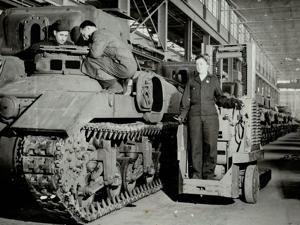Technology
Canadian Industrial Leaders Transformed War Production During WWII

During World War II, a select group of Canadian businessmen, often referred to as “dollar-a-year” men, played a crucial role in transforming Canada’s economy into a wartime powerhouse. Among them, Harry Carmichael emerged as a key figure, overseeing wartime production and ensuring that Canada became the fourth largest industrial power globally. This article explores Carmichael’s contributions and the broader impact of these men, as chronicled in Allan Levine‘s book, “The Dollar a Year Men: How the Best Business Brains in Canada Helped to Win the Second World War.”
Carmichael’s journey began in September 1891 in New Haven, Connecticut, where he was born to a British engineer and his wife. He grew up to be a skilled baseball player but shifted his focus to business after a minor injury halted his athletic aspirations. In 1908, he started his career at a local hardware firm before moving to St. Catharines, Ontario, in 1912 to work as a pattern maker for McKinnon Industries. This company eventually attracted the attention of General Motors, which acquired it in 1929. By 1936, Carmichael had risen to vice-president and general manager of GMC Canada.
As the war escalated, Carmichael felt compelled to contribute to the national effort. He resigned from GMC in early 1941 and joined the newly established Wartime Requirements Board. His transition from the private sector to government was notable; GMC’s president at the time, R.S. McLaughlin, acknowledged the significant loss of talent but recognized the importance of Carmichael’s role in the war effort.
C.D. Howe, the influential cabinet minister leading the Department of Munitions and Supply, quickly identified Carmichael’s potential. In February 1941, he appointed him as co-director of munitions production, placing him in charge of critical areas such as guns, tanks, and bombs. Despite having no prior experience in munitions, Carmichael’s business acumen proved invaluable. He effectively coordinated production efforts and implemented strategies that would prove essential for Canada’s wartime manufacturing capabilities.
Carmichael’s leadership was marked by a series of strategic initiatives that significantly boosted production. By the summer of 1942, he had already overseen a dramatic increase in the output of rifles and machine guns. Production of rifles and pistols soared from 6,847 in 1941 to 220,240 in 1942, reflecting a remarkable increase of over 3,100 percent. Similarly, machine gun production surged from 17,860 units to 159,918 in the same period.
Carmichael’s approach included recruiting skilled workers from the United Kingdom and adopting American mass production techniques. He recognized that Canada relied heavily on British technology and sought to improve production efficiency. As he noted, “the blueprints and products often didn’t go together; the Brits knew the shortcuts and unofficial adjustments that were necessary.” By the end of the war, Canada had achieved self-reliance in munitions production.
Under Carmichael’s guidance, various Canadian industries adapted to wartime needs. Factories that once focused on civilian goods transformed their operations to manufacture military equipment. For instance, a company known for making bicycles began producing gun parts, while a former refrigerator factory became adept at creating tank turrets. Carmichael emphasized the importance of subcontracting, a technique he’d honed at GMC, to facilitate the complex task of producing numerous components across the country. This “bits and pieces” system, as Howe referred to it, streamlined production and allowed for greater efficiency.
The impact of Carmichael’s leadership extended beyond production numbers. His commitment to the workforce was evident; he often covered his own expenses while serving as a dollar-a-year man. He was dedicated to ensuring that the men and women in factories were not only productive but also valued. As noted in a Globe and Mail editorial upon his retirement in October 1945, Carmichael was praised for his “industrial know-how” and his ability to streamline production processes.
Reflecting on his wartime service in 1943, Carmichael expressed immense pride in what had been accomplished. He considered the experience “the greatest thrill of my life,” despite the toll it took on his health. He highlighted the ingenuity and adaptability that Canadian industry displayed in meeting wartime demands, remarking, “Canada has achieved something of an industrial miracle in converting and expanding its peacetime production capacity to wartime needs.”
Carmichael’s legacy as a wartime production leader remains significant. His ability to navigate the complexities of industrial production during a time of crisis helped to solidify Canada’s status as a key player in the global war effort. The innovative and collaborative spirit fostered by Carmichael and his fellow dollar-a-year men not only contributed to military successes but also laid the groundwork for Canada’s post-war industrial landscape.
-

 World4 months ago
World4 months agoScientists Unearth Ancient Antarctic Ice to Unlock Climate Secrets
-

 Entertainment4 months ago
Entertainment4 months agoTrump and McCormick to Announce $70 Billion Energy Investments
-

 Lifestyle4 months ago
Lifestyle4 months agoTransLink Launches Food Truck Program to Boost Revenue in Vancouver
-

 Science4 months ago
Science4 months agoFour Astronauts Return to Earth After International Space Station Mission
-

 Technology2 months ago
Technology2 months agoApple Notes Enhances Functionality with Markdown Support in macOS 26
-

 Top Stories3 weeks ago
Top Stories3 weeks agoUrgent Update: Fatal Crash on Highway 99 Claims Life of Pitt Meadows Man
-

 Sports4 months ago
Sports4 months agoSearch Underway for Missing Hunter Amid Hokkaido Bear Emergency
-

 Politics3 months ago
Politics3 months agoUkrainian Tennis Star Elina Svitolina Faces Death Threats Online
-

 Politics4 months ago
Politics4 months agoCarney Engages First Nations Leaders at Development Law Summit
-

 Technology4 months ago
Technology4 months agoFrosthaven Launches Early Access on July 31, 2025
-

 Top Stories1 week ago
Top Stories1 week agoFamily Remembers Beverley Rowbotham 25 Years After Murder
-

 Entertainment4 months ago
Entertainment4 months agoCalgary Theatre Troupe Revives Magic at Winnipeg Fringe Festival





















